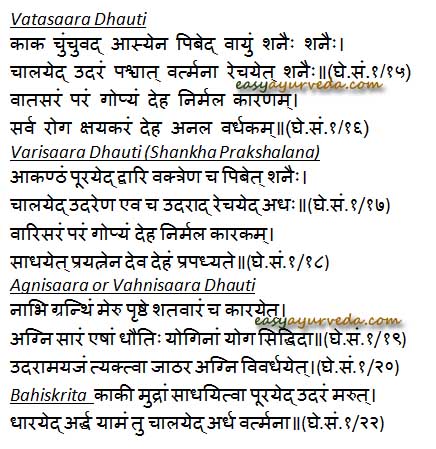Antardhauti: Types, Benefits, Right Procedure
Article by Dr Raghuram Y.S. MD (Ay) & Dr Manasa, B.A.M.S
Dhauti is one of the six cleansing procedures advised in Hatha Yoga Practice. Dhauti means, “to cleanse”. There are four types of Dhauti –
Antardhauti, Danta Dhauti, Hrid Dhauti and Moola Shodhana
Table of Contents
Antardhauti
Antardhauti is a procedure in which the interior of the body is cleansed. It is of below mentioned 4 types –
a. Vatasaara Dhauti
b. Varisaara Dhauti (Shankha Prakshalana)
c. Agnisaara or Vahnisaara Dhauti
d. Bahiskrita
Read related: Dhauti Karma: Right Method, Types, Benefits, Contra Indications

a. Vatasaara Dhauti
How to do?
- The mouth is contracted and made like the crow’s beak
- With the contracted mouth, the air is slowly drunk (sucked in)
- The stomach is gradually filled with air while continuously sucking it from the mouth
- This air should now be propelled slowly in downward direction and excreted through the lower passage (anus)
Benefits –
- Cleanses the body
- Destroys all the diseases
- Enhances the agni (digestion capacity, metabolism)
b. Varisaara Dhauti
Also known as Shankha Prakshalana.
How to do?
- Water is filled in the mouth up to the throat
- The water is slowly swallowed (drank)
- This water moves to the stomach
- The water filled in the stomach should be propelled in downward direction and should be removed through the rectum
The terms Varisara Dhauti and Shankha Prakshalana are often used interchangeably because of the similarity of the procedures, though not exactly. Laghu Shankha Prakshalana is a variant of Shankha Prakshalana. In both these procedures saline water is orally consumed and excreted through the anal route.
Benefits –
- Cleanses the body
- On constant practice, it provides ‘devadeha’ e. a divine or Godly body (shining body)
c. Vahnisaara Dhauti
Also called Agnisaara Dhauti.
How to do?
- Keep a finger in the navel pit
- With your finger press the navel region (intestines) backwards towards the spine
- Do this procedure for hundred times
- This is called Agnisaara dhauti because it helps in kindling the digestive fire. It provides the doer with Yoga siddhi (success in the practice of yoga)
The practice of Agnisaara Dhauti involves conscious movement of the abdominal muscles and organs which induce internal heat.
Agnisaara Dhauti is also a useful practice which is done as a part of preparation for Kapalabhati and Bhastrika Pranayama procedures.
Other forms of doing Vahnisaara Dhauti –
Simple form of Vahnisaara Dhauti
- Sit in Vajrasana pose
- Keep the toes together and separate the knees as far as possible. Place the hands on your knees and keep the arms straight. Lean forwards slightly.
- Open the mouth and extend the tongue outside.
- Breathe rapidly in and out simultaneously expanding and contracting the belly (abdomen). The rapid breathing should resemble the panting of a dog.
- Breathe in and out up to 25 times.
- Advanced practitioners who have mastered the art of doing this procedure, can perform up to 50-100 breathes.
Advanced form of Agnisaara Dhauti –
- Exhale as deeply as possible.
- Perform Jalandhara Bandha (chin lock).
- Rapidly expand and contract the abdominal muscles for as long as you are able to retain the breath.
- Both simple form and advanced form of Agnisara Dhauti can be performed in standing position.
Benefits –
- Cures all the udaramayas (diseases of the abdomen, gut related disorders or digestive disorders)
- Enhances Jatharagni (digestive fire, capacity to digest the food, metabolism)
- Gives massage to abdominal nerves, strengthens the muscles and stimulates the associated nerves. It encourages the proper functioning of abdominal organs.
- It promotes proper secretion of digestive juices, thus allowing maximum assimilation and utilization of nutrients.
- It helps to prevent and cure many diseases related to errors of digestion including constipation, indigestion, hyperacidity, flatulence, constipation and sluggish liver.
4. Bahiskrita
How to do?
- Make your mouth like the shape of a crow’s beak
- Suck the air and fill your stomach with air
- Retain this air in your stomach for one and half hour
- After one and half hour or 90 minutes, push the air in the stomach downwards, towards the intestines
- Now stand in the water to navel-deep.
- Draw out the Shaktinadi or intestines, wash it with hand and draw it inside the body once again
- This is a tough procedure and one needs to master it through constant practice. This is not possible until one can withhold his or her breath for at least one hour.
Note – This dhauti is for Yogis and cannot be practiced by common people.
Click to Consult Dr Raghuram Y.S. MD (Ayu)









